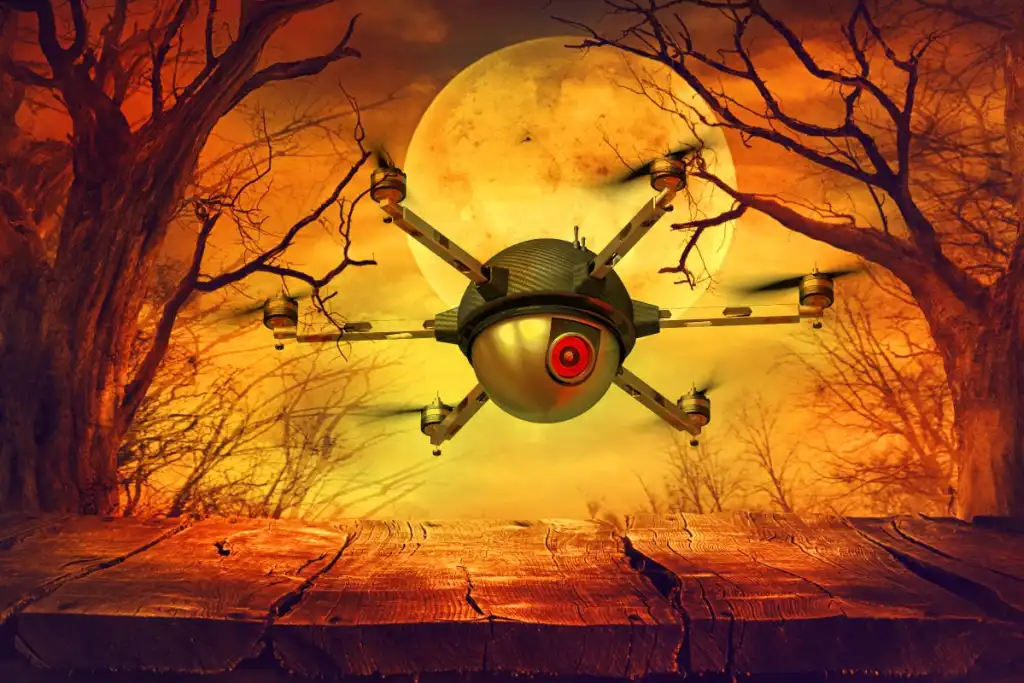Introduction
AI-powered killer robot drones are no longer just a concept from science fiction. They have become a reality, reshaping the landscape of modern warfare and raising significant ethical, legal, and technological questions. These advanced machines, capable of autonomous decision-making and execution of missions, are at the forefront of military innovation. Understanding their rise is crucial as it impacts global security, international relations, and the future of warfare.
The Evolution of Drones
Drones, or unmanned aerial vehicles (UAVs), have come a long way since their inception. Initially used for simple reconnaissance missions, early drones required human operators for control and navigation. Over the years, technological advancements have led to the integration of AI, transforming these devices into sophisticated, autonomous systems capable of executing complex tasks with minimal human intervention.
AI Integration in Modern Drones
The integration of AI in modern drones has revolutionized their capabilities. AI algorithms enable drones to process vast amounts of data in real time, making intelligent decisions on the fly. From identifying targets to navigating complex environments, AI-powered drones exhibit a level of efficiency and precision that was previously unattainable. Machine learning, neural networks, and advanced sensor technology play pivotal roles in enhancing these capabilities.
Military Applications of AI-Powered Drones
Surveillance and Reconnaissance
AI-powered drones are invaluable for surveillance and reconnaissance missions. Equipped with advanced cameras and sensors, these drones can gather and analyze data from vast areas, providing real-time intelligence to military commanders. This capability enhances situational awareness and allows for more informed decision-making on the battlefield.
Offensive Operations
In offensive operations, AI-powered drones can identify and engage targets autonomously. These drones can be programmed to strike with precision, reducing collateral damage and increasing mission success rates. Their ability to operate in hostile environments without risking human lives makes them a preferred choice for many military operations.
Ethical Concerns
The rise of AI-powered killer robot drones has sparked intense ethical debates. One of the primary concerns is the delegation of life-and-death decisions to machines. The potential for misuse by rogue states or non-state actors also raises alarms. Furthermore, the lack of accountability and the possibility of unintended consequences make the deployment of these drones a contentious issue.
Legal and Regulatory Challenges
Current Laws Governing AI in Warfare
The legal framework governing the use of AI in warfare is still evolving. International laws such as the Geneva Conventions provide some guidelines, but they are often insufficient to address the complexities introduced by AI technology. There is a growing need for comprehensive regulations that specifically address the use of autonomous weapons.
International Stance on Killer Robots
Countries around the world are divided on the issue of AI-powered killer robots. While some advocate for a complete ban on autonomous weapons, others argue for their strategic advantages. International organizations, including the United Nations, are working towards establishing common ground, but reaching a consensus remains challenging.
Technological Advancements Driving the Rise
The rapid advancement in machine learning and neural networks has been a significant driver behind the rise of AI-powered drones. These technologies enable drones to learn from vast datasets, improving their performance over time. Additionally, advancements in sensor technology allow drones to perceive their environment more accurately, enhancing their operational capabilities.
Case Studies of AI-Powered Drone Usage
Real-World Examples
Several case studies highlight the effectiveness and challenges of using AI-powered drones. For instance, during recent conflicts, AI drones have been deployed for targeted strikes and surveillance missions. These examples demonstrate the potential of AI in enhancing military operations but also underscore the need for stringent controls to prevent misuse.
Lessons Learned
The lessons learned from these case studies emphasize the importance of ethical considerations and robust regulatory frameworks. They also highlight the need for continuous technological advancements to address emerging threats and challenges.
Comparisons with Traditional Warfare
Efficiency and Precision
AI-powered drones offer a level of efficiency and precision that traditional methods cannot match. Their ability to process data rapidly and make real-time decisions enhances mission success rates. Additionally, their precision in targeting reduces the risk of collateral damage, making them a more humane option in some scenarios.
Reduced Human Casualties
One of the most significant advantages of AI-powered drones is the reduction of human casualties. By taking on dangerous missions, these drones protect soldiers from harm. This capability is particularly valuable in high-risk operations where human lives are at significant risk.
Public Perception and Media Representation
The public perception of AI-powered drones is mixed. While some view them as technological marvels that enhance security, others fear their potential for abuse and the ethical dilemmas they pose. Media representation often influences these perceptions, with sensationalized reports sometimes overshadowing the nuanced realities of their use.
Future Prospects
Predictions for AI in Military Technology
The future of AI in military technology looks promising. Experts predict further advancements in AI algorithms, making drones even more capable and reliable. There is also potential for integrating AI with other emerging technologies, such as quantum computing and advanced robotics, to create even more sophisticated systems.
Potential for Civilian Applications
Beyond military uses, AI-powered drones have significant potential in civilian applications. They can be used for disaster response, environmental monitoring, and delivery services, among other things. However, the ethical and regulatory challenges associated with their military use will need to be addressed to ensure safe and responsible deployment in civilian contexts.
The Role of Global Powers
How Major Countries Are Developing AI Drones
Major global powers, including the United States, China, and Russia, are heavily investing in AI-powered drone technology. These countries view AI drones as strategic assets that can provide significant military advantages. The race to develop the most advanced AI drones is intensifying, with each nation striving to outpace the others.
Strategic Advantages and Geopolitical Implications
The deployment of AI-powered drones offers strategic advantages, such as increased operational efficiency and reduced human risk. However, it also has geopolitical implications. The proliferation of these drones could lead to an arms race, increasing tensions between global powers and potentially destabilizing international relations.
Preventative Measures and Safeguards
Proposed Measures to Control AI Weaponry
To mitigate the risks associated with AI-powered drones, various measures have been proposed. These include international treaties, strict regulatory frameworks, and the development of fail-safes to prevent unintended actions. Ensuring transparency and accountability in the development and deployment of AI weapons is also crucial.
Role of International Organizations
International organizations, such as the United Nations, play a vital role in addressing the challenges posed by AI-powered drones. These organizations can facilitate dialogue between countries, promote the establishment of international norms, and oversee compliance with agreed-upon regulations.
Economic Impacts
Cost of Developing and Deploying AI Drones
The development and deployment of AI-powered drones require significant financial investment. Research and development costs, production expenses, and maintenance all contribute to the overall cost. However, the long-term benefits, such as reduced personnel costs and increased operational efficiency, can offset these initial investments.
Economic Benefits Versus Risks
While the economic benefits of AI-powered drones are substantial, including job creation in the tech sector and advancements in related industries, the risks cannot be overlooked. The potential for job displacement, ethical dilemmas, and the high cost of ensuring safe deployment are significant considerations.
Conclusion
The rise of AI-powered killer robot drones represents a significant technological advancement with profound implications for modern warfare and global security. While they offer numerous benefits, including increased efficiency, precision, and reduced human casualties, they also raise ethical, legal, and regulatory challenges that must be addressed. As technology continues to evolve, policymakers, military leaders, and international organizations must work together to ensure that AI-powered drones are developed and used responsibly.
FAQs
What are AI-powered killer robot drones?
AI-powered killer robot drones are autonomous unmanned aerial vehicles equipped with artificial intelligence that allows them to perform complex tasks, including identifying and engaging targets without human intervention.
How do AI-powered drones differ from traditional drones?
Traditional drones require human operators for control and decision-making, whereas AI-powered drones can operate autonomously, making decisions based on real-time data and pre-programmed algorithms.
What are the main ethical concerns regarding AI-powered drones?
The primary ethical concerns include the delegation of life-and-death decisions to machines, the potential for misuse by malicious actors, and the lack of accountability for actions taken by autonomous systems.
Are there any international laws regulating AI-powered drones?
Currently, there are limited international laws specifically regulating AI-powered drones. Existing laws, such as the Geneva Conventions, provide some guidelines, but comprehensive regulations are still under development.
What does the future hold for AI-powered drones in warfare?
The future of AI-powered drones in warfare includes further advancements in AI technology, increased integration with other emerging technologies, and expanded applications in both military and civilian contexts. However, addressing ethical, legal, and regulatory challenges will be crucial for their responsible use.


